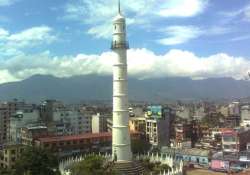Know more about Dharahara 'Bhimsen Tower' that turned into rubble after Nepal quake
Built in 1832, under the commission of the then Prime Minister Bhimsen Thapa- the iconic ‘Dharahara' tower also famous as Bhimsen Tower, was a nine-storey, 61.88-metre-tall (203.0 ft) tower at the center of Sundhara in

Built in 1832, under the commission of the then Prime Minister Bhimsen Thapa- the iconic ‘Dharahara' tower also famous as Bhimsen Tower, was a nine-storey, 61.88-metre-tall (203.0 ft) tower at the center of Sundhara in Kathmandu.
This historic building was a part of the Architecture of Kathmandu recognized by UNESCO. To have a panoramic view of the Kathmandu valley people used to get to the top of the balcony. To get to the top of the building one has to climb 213 spiral staircases.
From far one could see and recognize tower's 5.2 metres (17 ft) bronze mast on the roof.
‘Dharahara' in Kathmandu was the tallest building in Nepal and second such tower built by the then Prime Minister Bhimsen Thapa. The first tower was built in 1824 and was 11 stories high, two stories taller than the demolished Dharahara at present. Dharahara is said to be built for Queen Lalit Tripura Sundari, who was the niece of Bhimsen Thapa.
During the earthquake of 1834, both towers survived the jolt. At that time Bhimsen the tower had suffered severe damage. Again on January 15, 1934, an earthquake shook the Bhimsen's first tower and destroyed it completely. Only two of the 11 stories of the second tower remained.
Bhimsen Thapa (the Mukhtiyar of Nepal from 1806 to 1837) along with Juddha Shumsher (Prime Minister of Nepal from 1 September 1932 to 29 November 1945) carried out the renovation work of the Dharahara tower. While the Bhimsen Tower was being obliterated, Queen Lalit Tripura Sundari's tower got its name, 'Bhimsen Stambha' or 'Bhimsen Tower'.
How was this iconic tower used?
Dharahara was built for military use. The army used it as the watchtower of the city. They used to guard the city by climbing up there. To give any sort of information to the soldier's bugles were blown from the top of the tower. Till the iconic tower collapsed there was a tradition of bugle trumpeting that was later discontinued.
Architecture of Dharahara tower
The architecture of the tower was designed in Mughal and European style. A small statue of Lord Shiva was placed on the top of the tower. It was also considered to resemble an Islamic minaret.
How Nepal saw Dharahara's destruction?
The powerful temblor measuring 7.9 on the Richter scale on April 25, 2015 levelled the nation's tangible cultural history, robbing it of its architectural jewels, including the landmark Dharhara Tower, in an eerie reminder of the 1934 quake that claimed over 10,000 lives. The earthquake's epicenter was approximately 29 kilometres (18 mi) east-southeast of Lamjung and claimed over 3700 lives Nepal. The structure collapsed and only its base survived.
The Kathmandu Valley inscribed in the World Heritage list in 1979 includes the Durbar Squares - Hanuman Dhoka, Patan and Bhaktapur respectively. The Buddhist stupas of Swayambhu and Bouddhanath, Pashupati Nath Temple and Changu Narayan too were included in the WHO sites.
Unfortunately, the tragedy came to revisit all the three Squares, as the sites had suffered extensive damage in the 1934 disaster too. It also didn't spare Changhu Narayan temple.
How it will affect Nepal's Tourism?
The tower was open to the public from 2005 until it collapsed in 2015. The fare for entering the site and ascending the tower was set at the following rates.
For Locals - NPR 50
For Locals over age 65 & under 5 - Free
For Foreigners - Around US$4.00 converted to NPR
SAARC Nationals - Around US$1.00 converted to NPR
These historic towers represented Nepal, its culture and beauty, and it's all gone now. But we pray Nepal recovers from nature's fury soon and gain its beauty back!